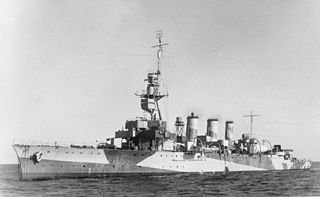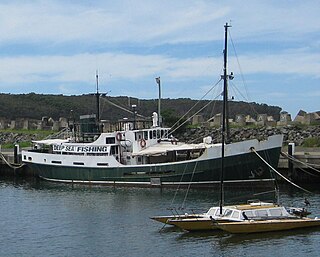
HMAS Barcoo (K375/F375/A245) was a River-class frigate of the Royal Australian Navy (RAN). One of twelve frigates constructed in Australia during World War II, Barcoo, was laid down by Cockatoo Docks & Engineering Company, Sydney in 1942, and commissioned in early 1944.

HMAS Bataan (D9/I91/D191) was a Tribal-class destroyer of the Royal Australian Navy (RAN). Laid down in 1942 and commissioned in 1945, the destroyer was originally to be named Chingilli or Kurnai but was renamed prior to launch in honour of the US stand during the Battle of Bataan.

HMAS Adelaide was a Town-class light cruiser of the Royal Australian Navy (RAN), named after Adelaide, the capital city of South Australia. Laid down in 1915, wartime shortages and design modifications meant the ship was not completed until 1922, earning her the nickname "HMAS Longdelayed".

HMAS Quiberon (G81/D20/D281/F03) was a Q-class destroyer of the Royal Australian Navy (RAN). Although built for the Royal Navy and remaining British property until 1950, Quiberon was one of two Q-class destroyers commissioned into the RAN during World War II. She was passed into full RAN ownership in 1950, and converted into an anti-submarine frigate.

HMAS Quickmatch (G92/D21/D292/F04) was a Q-class destroyer operated by the Royal Australian Navy (RAN). Although commissioned into the RAN in 1942, the ship was initially the property of the Royal Navy. Quickmatch served with both the British Eastern Fleet and British Pacific Fleet during World War II. In the 1950s, the destroyer was converted into an anti-submarine frigate. In 1957, Quickmatch operated in support of Malaya during the Malayan Emergency. The ship remained in service until 1963, and after use as an accommodation ship, was sold for scrap in 1972.
HMAS Acute was an Attack class patrol boat operated by the Royal Australian Navy (RAN).

HMAS Echuca (J252/M252), named for the town of Echuca, Victoria, was one of 60 Bathurst-class corvettes constructed during World War II, and one of 36 initially manned and commissioned by the Royal Australian Navy (RAN).
HMAS Flinders, named for Matthew Flinders (1774–1814), was a hydrographic survey ship of the Royal Australian Navy (RAN). Built by HMA Naval Dockyard at Williamstown, Victoria, Flinders was commissioned into the RAN in 1973, and was used to conduct hydrographic surveys in the waters to Australia's north, including parts of New Guinea. In 1974, the ship was tasked with assisting clean up efforts in the wake of Cyclone Tracy, which devastated large parts of Darwin. The ship was decommissioned in 1998 and sold to civilian operators, who have since converted her into a private yacht in the Cayman Islands.

HMAS Kalgoorlie (J192/B245/A119), named for the city of Kalgoorlie, was one of 60 Bathurst-class corvettes constructed during World War II and one of 20 built for the Admiralty but manned by personnel of and commissioned into the Royal Australian Navy (RAN).

HMAS Manoora was a passenger liner that served in the Royal Australian Navy (RAN) during World War II. She was built in Scotland in 1935 for the Cairns to Fremantle coastal passenger run for the Adelaide Steamship Company. She was requisitioned by the RAN for naval service in 1939. Manoora was initially converted into an armed merchant cruiser (AMC), operating primarily in Australian, New Guinea, and Pacific waters, with deployments to Singapore and the Bay of Bengal.

HMAS Banks was an Explorer class general-purpose vessel of the Royal Australian Navy (RAN), serving in a range of capacities from 1960 until 1995. She was named in honour of Sir Joseph Banks, the botanist aboard HM Bark Endeavour during the discovery of the eastern coast of Australia in 1770.

HMAS Whyalla (J153/B252), named for the city of Whyalla was one of 60 Bathurst-class corvettes constructed during World War II and one of 20 built on Admiralty order but manned by personnel of and later commissioned into the Royal Australian Navy (RAN). The ship was sold to the Victorian Public Works Department at the end of the war, who renamed her Rip and used her as a maintenance ship. In 1984, she was purchased by Whyalla City Council, who put her on display as a landlocked museum ship in 1987.

HMAS Gawler (J188/B241/A115), named for the town of Gawler, was one of 60 Bathurst-class corvettes constructed during World War II and one of 20 built for the Admiralty but manned by personnel of and commissioned into the Royal Australian Navy (RAN). The ship was laid down by BHP at its Whyalla shipyard in early 1941, launched later that year, and commissioned in 1942.

Following World War II the Royal Australian Navy (RAN) was required to clear naval mines from the waters around Australia and New Guinea. Minesweeping in these areas began in December 1945 and was completed in August 1948. One ship, the Bathurst class corvetteHMAS Warrnambool, was sunk during these operations.

HMAS Doomba was a Royal Australian Navy (RAN) warship of World War II. Built for the Royal Navy around the end of World War I as the Hunt-class minesweeper HMS Wexford, the ship only saw two years of service before she was decommissioned in 1921 and sold to the Doomba Shipping Company. The vessel was renamed SS Doomba, converted into a passenger ship, and operated in the waters around Brisbane until 1939, when she was requisitioned by the RAN for wartime service. Serving first as an auxiliary minehunter, then an auxiliary anti-submarine vessel, HMAS Doomba was purchased outright by the RAN in 1940, and served until early 1946, when she was sold and converted into a linseed oil lighter. Doomba was scuttled off Dee Why, New South Wales in 1976.

HMAS Ping Wo was a 3,105 tons former Indo-Chinese river steamer that was commissioned into the Royal Australian Navy (RAN) during World War II. The Chinese name translates to "Equitable Harmony". It was one of a group of vessels known as the "China Fleet" acquired by the RAN in similar circumstances.

HMAS Durraween (F93) was an auxiliary minesweeper operated by the Royal Australian Navy (RAN) during World War II. The ship was built as a trawler by Collingwood Shipbuilding Company at Collingwood, Ontario, Canada, and launched in 1918 as Seville. The ship served briefly in the Royal Canadian Navy during the last months of World War I, before being laid up and sold to a British company. In 1928, she was sold to Sydney-based fishing company and operated in Australian waters until she was requisitioned by the RAN in mid-1940 for use as an auxiliary minesweeper during World War II. Durraween operated in the Bass Strait as part of Minesweeping Group 54, and was responsible for clearing mines laid by German merchant raiders, and then later operated around the Torres Strait. She was returned to civilian service after paying off in late 1945, and was broken up in 1952.

HMAS Grantala was a hospital ship operated by the Royal Australian Navy (RAN) during World War I. She was launched in 1903 by Armstrong Whitworth Company for the Adelaide Steamship Company. The ship operated in Australian waters from 1903, and was requisitioned by the RAN on 7 August 1914. She was returned to her owners in 1915, then was sold and renamed Figuig. The ship was scrapped in 1934.

HMAS Yunnan (FL-151) was a 2,812-ton former steamer that was commissioned into the Royal Australian Navy (RAN) during the Second World War. It was one of a group of vessels known as the "China Fleet" acquired by the RAN in similar circumstances. During the war, the ship operated as an ammunition supply vessel in the Pacific. At the conclusion of hostilities, she was transferred to the British, and was eventually sold to civilian owners. She was broken up in 1971.
HMAS Tolga was an auxiliary minesweeper which served in the Royal Australian Navy (RAN) during World War II.

















